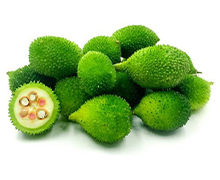
- Address : P.O. Box 11, Gannoruwa rd, Peradeniya, Sri Lanka
- E- Mail : director.hordi@doa.gov.lk
- Telephone :(+94) 081-2388011-12-13
- Fax :(+94) 081-2388234

Thumba Karawila
Momordica dioica ex Roxb.Willd
Spine gourd is a demand vegetable, grows mainly in flat low lands in Sri Lanka. Although it is a vine, belongs to the bitter gourd family, it has no bitter taste and is a food that is having medicinal value for diabetes and stomach ailments.
Released Varieties
Depending on the shape of the fruit, there are different types of plants: oval, cylindrical and spherical.
Female plant varieties – Thumbika / Golika / Wisal / Kesara / Chandu
Male plant Varieties – Parakum, wishma
Hybrid: Female -Chandu, male – Wishma
Climatic requirements/ Areas suitable for cultivation
Cultivation Lowland dry zone is more suitable.
Soil
Grows well in non-loamy reddish-brown soils, it can thrive in well-drained soils rich in organic matter.
Seed requirement
Required 6000 healthy female seedlings and 1000 male seedlings in the ratio of 6: 1 per hectare and 6000 healthy female seedlings and 600 male seedlings in the ratio of 10: 1. Both fruiting and flowering vines are required for fruiting.
Land preparation
Turn the soil to a depth of 20-30 Cm and crush the pebbles. Fill 30x30x30 cm deep pits with organic manure and top soil.
Cultivation Time
It is advisable to start sowing in the Maha season – September – October and in the Yala season – March – April. If additional water facilities are available, it is advisable to plant in mid-December after the end of the heavy rains of the Maha season. Planting can be done at any time of the year if water is available.
Preparation of planting material
Seedlings can be easily obtained using stem cuttings. Stem Cuttings with 2-4 inter-nodes are suitable for planting.
When propagated by tubers, obtain tubers with a few eyes after the dormancy period of about 4 months from the previous season. Cut those tubers into about 40g pieces and plant in a sand nursery. If the seeds are sown, store the seeds obtained from the previous season under normal conditions for about 9 months and plant 4 seeds in one place and remove the other seedlings at a ratio of 6:1 – 10: 1 for hybrids use of stem cutting is recommended.
Spacing
The spacing is 1.5 m between rows and 1.0 m between plants.
Fertilizer
| Fertilizer application | Urea Kg / ha. | TSP Kg / ha. | MOP Kg / ha. |
| Basic Fertilizer | 75 | 200 | 65 |
| after pruning the vines (3 weeks) | 75 | 200 | 65 |
at 4 – 8 weeks | 75 | – | 65 |
Note 1: It is best to apply phosphorus and potassium as basic fertilizers after a soil test.
Water supply
Provide adequate water to maintain suitable soil moisture for cultivation.
Weed Control
At a young age, uproot the weeds near the seedlings and then shovel them so as not to damage the base.
Pest Management
Epilacna larvae
Disease Management
Root rot can occur at any growth stage. This is a disease caused by fungi or bacteria. It is important to maintain good drainage in the field and remove diseased vines and apply a fungicide (thiophanate methyl 85% +, thiram 35% or Carbendazim) to thoroughly wet the soil around the vines to prevent spread.
Yellow powdery spots appear on the leaves. Later these spots turn to brown color. Gray whitish fungal spores are produced on the underside of leaves. Leaves which infected by diseases, become dry up. Dissolve 12 grams of Mancozeb 64% + , Metalaxyl 18% (Ridomil) fungicide in 10 liters of water and apply to the underside of the leaves.
Harvesting
- When plants initiated with seeds flowering begins at about 3 months after seeding.
- Flowers obtained 2 months after crop establishment using plant-lets obtained from stem cuttings.
Yield
Fruit yield 6.0 – 8.0 kg per year can be obtained from one female vine. Flowering takes place from 7.00 pm Until the next day about 8.00 p.m.
